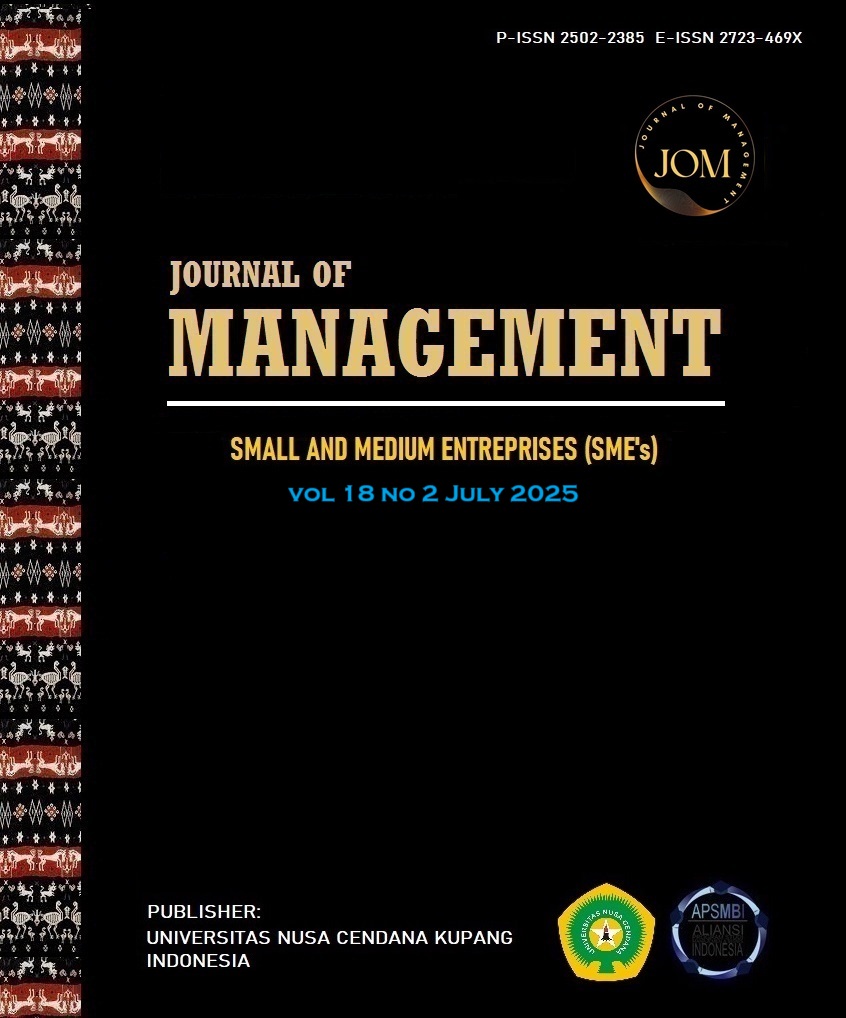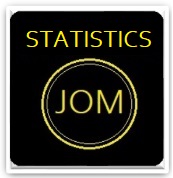THE EFFECT OF WORK SHIFT IMPLEMENTATION AND WORK MOTIVATION ON EMPLOYEE WORK PRODUCTIVITY AT PT SUMBER BINTANG REZEKI JIMBARAN SEMARANG REGENCY
Abstract
This study examines the influence of work shift implementation and work motivation on employee productivity at PT Sumber Bintang Rezeki Jimbaran in Semarang Regency. Using a quantitative approach with an explanatory survey method, data were collected from 38 employees through a structured questionnaire. Multiple regression analysis revealed that both work shift implementation and work motivation individually had significant positive effects on employee productivity. The two variables collectively explained 67.9% of the variance in employee productivity. The findings highlighted that while both factors significantly influence productivity, work motivation demonstrated a slightly stronger effect. Analysis of demographic data showed a predominantly female (84.2%) and young workforce (60.5% aged 20-25 years), which may influence shift adaptation and motivational patterns. The study contributes practical implications for manufacturing companies in Indonesia seeking to optimize productivity through effectively designed shift systems and targeted motivational strategies tailored to specific workforce demographics.
Keywords: Work Shift Implementation; Work Motivation; Employee Productivity; Manufacturing Industry; Indonesian Workforce
Downloads
References
Caruso, C. C., Baldwin, C. M., Berger, A., Chasens, E. R., Landis, C., Redeker, N. S., Scott, L. D., & Trinkoff, A. (2017). Position statement: Reducing fatigue associated with sleep deficiency and work hours in nurses. Nursing Outlook, 65(6), 766–768. https://doi.org/10.1016/j.outlook.2017.10.011
Cascio, W. F. (2018). Managing Human Resources: Productivity, Quality of Work Life, Profits (11th ed.). McGraw-Hill Education.
Cerasoli, C. P., Nicklin, J. M., & Ford, M. T. (2014). Intrinsic motivation and extrinsic incentives jointly predict performance: A 40-year meta-analysis. Psychological Bulletin, 140(4), 980–1008. https://doi.org/10.1037/a0035661
Chapdelaine, S., Paquet, J., & Dumont, M. (2012). Effects of partial circadian adjustments on sleep and vigilance quality during simulated night work. Journal of Sleep Research, 21(4), 380–389. https://doi.org/10.1111/j.1365-2869.2012.00998.x
Chen, Q., & Qi, J. (2023). How much should we trust R 2 and adjusted R 2 : evidence from regressions in top economics journals and Monte Carlo simulations. Journal of Applied Economics, 26(1). https://doi.org/10.1080/15140326.2023.2207326
Dall’Ora, C., Ball, J., Recio-Saucedo, A., & Griffiths, P. (2016). Characteristics of shift work and their impact on employee performance and wellbeing: A literature review. International Journal of Nursing Studies, 57, 12–27. https://doi.org/10.1016/j.ijnurstu.2016.01.007
Daniel, J. (2012). Choosing Between Taking a Census and Sampling. In Sampling Essentials: Practical Guidelines for Making Sampling Choices (pp. 23–65). SAGE Publications, Inc. https://doi.org/10.4135/9781452272047.n2
Di Milia, L., Waage, S., Pallesen, S., & Bjorvatn, B. (2013). Shift Work Disorder in a Random Population Sample – Prevalence and Comorbidities. PLoS ONE, 8(1), e55306. https://doi.org/10.1371/journal.pone.0055306
Ferguson, S. A., & Dawson, D. (2012). 12-h or 8-h shifts? It depends. Sleep Medicine Reviews, 16(6), 519–528. https://doi.org/10.1016/j.smrv.2011.11.001
Flatt, C., & Jacobs, R. L. (2019). Principle Assumptions of Regression Analysis: Testing, Techniques, and Statistical Reporting of Imperfect Data Sets. Advances in Developing Human Resources, 21(4), 484–502.
https://doi.org/10.1177/1523422319869915
Folkard, S., & Tucker, P. (2003). Shift work, safety and productivity. Occupational Medicine, 53(2), 95–101. https://doi.org/10.1093/occmed/kqg047
Gagné, M., Forest, J., Vansteenkiste, M., Crevier-Braud, L., van den Broeck, A., Aspeli, A. K., Bellerose, J., Benabou, C., Chemolli, E., Güntert, S. T., Halvari, H., Indiyastuti, D. L., Johnson, P. A., Molstad, M. H., Naudin, M., Ndao, A., Olafsen, A. H., Roussel, P., Wang, Z., & Westbye, C. (2015). The Multidimensional Work Motivation Scale: Validation evidence in seven languages and nine countries. European Journal of Work and Organizational Psychology, 24(2), 178–196.
https://doi.org/10.1080/1359432X.2013.877892
Guest, D. E. (2017). Human resource management and employee well‐being: towards a new analytic framework. Human Resource Management Journal, 27(1), 22–38. https://doi.org/10.1111/1748-8583.12139
Hair, J. F., Babin, B. J., Anderson, R. E., & Black, W. C. (2019). Multivariate Data Analysis (8th ed.). Pearson Prentice.
Harrington, J. M. (2001). Health effects of shift work and extended hours of work. Occupational and Environmental Medicine, 58(1), 68–72. https://doi.org/10.1136/oem.58.1.68
Herzberg, F., Mausner, B., & Snyderman, B. B. (2011). The Motivation to Work (12th ed.). Transaction Publishers.
İbrahimoğlu, N., & Mert, I. S. (2016). An Explanatory Research To Detect The Managerial Business Ethics Competencies And Unethical Managerial Behaviors. Journal of Academic Research in Economics (JARE), 8(1), 101–114.
Jabbour, C. J. C., Jabbour, A. B. L. de S., Govindan, K., Teixeira, A. A., & Freitas, W. R. de S. (2013). Environmental management and operational performance in automotive companies in Brazil: the role of human resource management and lean manufacturing. Journal of Cleaner Production, 47, 129–140.
https://doi.org/10.1016/j.jclepro.2012.07.010
Kanfer, R., Frese, M., & Johnson, R. E. (2017). Motivation related to work: A century of progress. Journal of Applied Psychology, 102(3), 338–355. https://doi.org/10.1037/apl0000133
Kecklund, G., & Axelsson, J. (2016). Health consequences of shift work and insufficient sleep. BMJ, i5210. https://doi.org/10.1136/bmj.i5210
Kuvaas, B., Buch, R., Weibel, A., Dysvik, A., & Nerstad, C. G. L. (2017). Do intrinsic and extrinsic motivation relate differently to employee outcomes? Journal of Economic Psychology, 61, 244–258. https://doi.org/10.1016/j.joep.2017.05.004
Mathis, R. L., Jackson, J., Valentine, S., & Meglich, P. (2016). Human Resource Management (15th ed.). Cengage Learning.
McMenanin, T. (2007). A time to work: Recent trends in shift work and flexible schedules. Monthly Labor Review, 130(12), 3–15.
https://www.bls.gov/opub/mlr/2007/12/art1full.pdf
Moreno, C. R. C., Marqueze, E. C., Sargent, C., Wright Jr, K. P., Ferguson, S. A., & Tucker, P. (2019). Working Time Society consensus statements: Evidence-based effects of shift work on physical and mental health. Industrial Health, 57(2), 139–157. https://doi.org/10.2486/indhealth.SW-1
Muecke, S. (2005). Effects of rotating night shifts: literature review. Journal of Advanced Nursing, 50(4), 433–439. https://doi.org/10.1111/j.1365-2648.2005.03409.x
Nie, Y., Chua, B. L., Yeung, A. S., Ryan, R. M., & Chan, W. Y. (2015). The importance of autonomy support and the mediating role of work motivation for well-being: Testing self-determination theory in a Chinese work organisation. International Journal of Psychology, 50(4), 245–255. https://doi.org/10.1002/ijop.12110
Pancasila, I., Haryono, S., & Sulistyo, B. A. (2020). Effects of Work Motivation and Leadership toward Work Satisfaction and Employee Performance: Evidence from Indonesia. The Journal of Asian Finance, Economics and Business, 7(6), 387–397. https://doi.org/10.13106/jafeb.2020.vol7.no6.387
Purwanto, A., Bernarto, I., Asbari, M., Wijayanti, L. M., & Hyun, C. C. (2020). Effect of Transformational and Transactional Leadership Style on Public Health Centre Performance. Journal of Research in Business, Economics, and Education, 2(1), 304–314.
Qulsum, L. N., & Kadir, K. (2024). Influence of Intrinsic Motivation and Compensation on Employee Performance: Study at one of the companies operating in the Fashion sector in Bandung City. Electronic, Business, Management and Technology Journal, 2(1), 43–55. https://doi.org/10.55208/ebmtj.v2i1.146
Rahmah, A., Artiningsih, D. W., & Wicaksono, T. (2023). Influence of Work Engagement and Organizational Culture on Employee Performance in Banjarmasin Islamic Hospital. Journal of Business Management and Economic Development, 2(01), 337–353. https://doi.org/10.59653/jbmed.v2i01.509
Riani, M., Atkinson, A. C., Morelli, G., & Corbellini, A. (2025). The Use of Modern Robust Regression Analysis with Graphics: An Example from Marketing. Stats, 8(1), 6. https://doi.org/10.3390/stats8010006
Robbins, S. P., & Judge, T. A. (2023). Organizational Behavior (19th ed.). Pearson.
Ryan, R. M., & Deci, E. L. (2020). Intrinsic and extrinsic motivation from a self-determination theory perspective: Definitions, theory, practices, and future directions. Contemporary Educational Psychology, 61, 101860. https://doi.org/10.1016/j.cedpsych.2020.101860
Safitri, R., & Saputra, E. (2023). The Impact Of Work Family Conflict And Burnout On Employee Performance: Mediation Of Organizational Commitment. Jurnal Dimensi, 12(3), 786–794. https://doi.org/10.33373/dms.v12i3.5717
Sutanto, E., Scheller-Sampson, J., & Mulyono, F. (2018). Organizational justice work environment and motivation. International Journal of Business and Society, 19, 313–322.
Tagliaro, C., Orel, M., & Hua, Y. (2023). Methodological Approaches for Workplace Research and Management. In Methodological Approaches for Workplace Research and Management. https://doi.org/10.1201/9781003289845
Wickramasinghe, V., & Perera, S. (2014). Effects of perceived organisation support, employee engagement and organisation citizenship behaviour on quality performance. Total Quality Management & Business Excellence, 25(11–12), 1280–1294. https://doi.org/10.1080/14783363.2012.728855

 Leoni Angela Fau(1)
Leoni Angela Fau(1)



